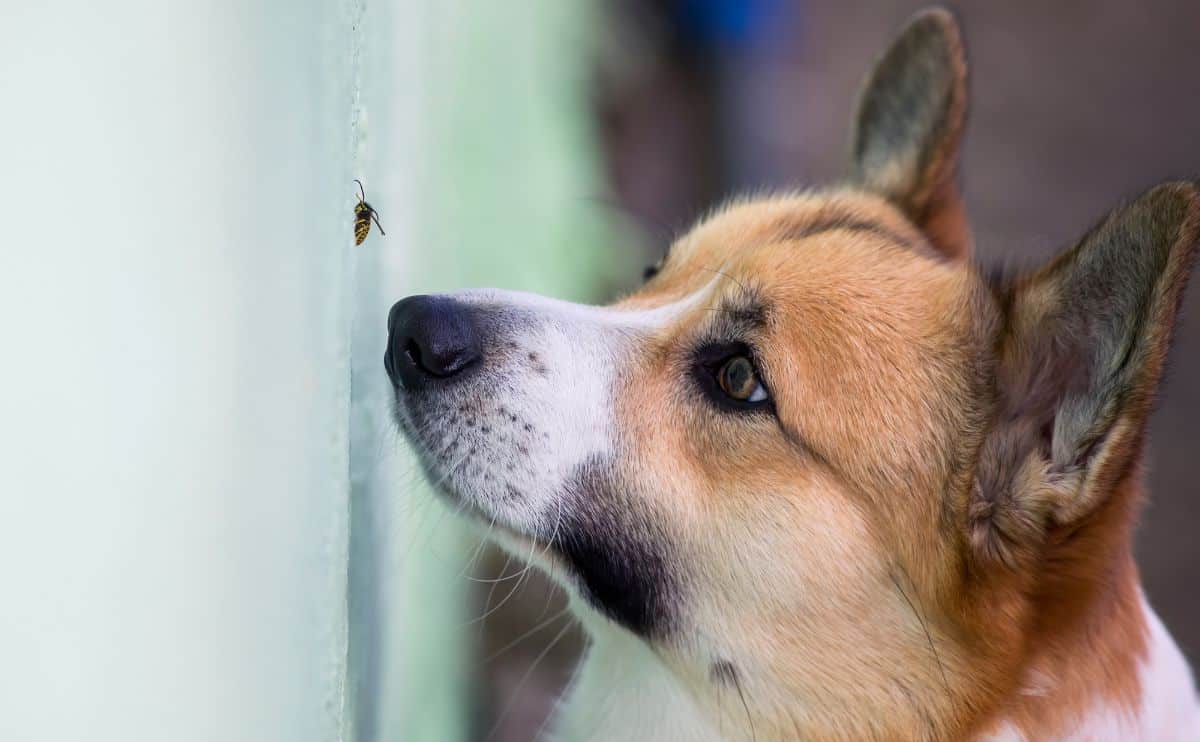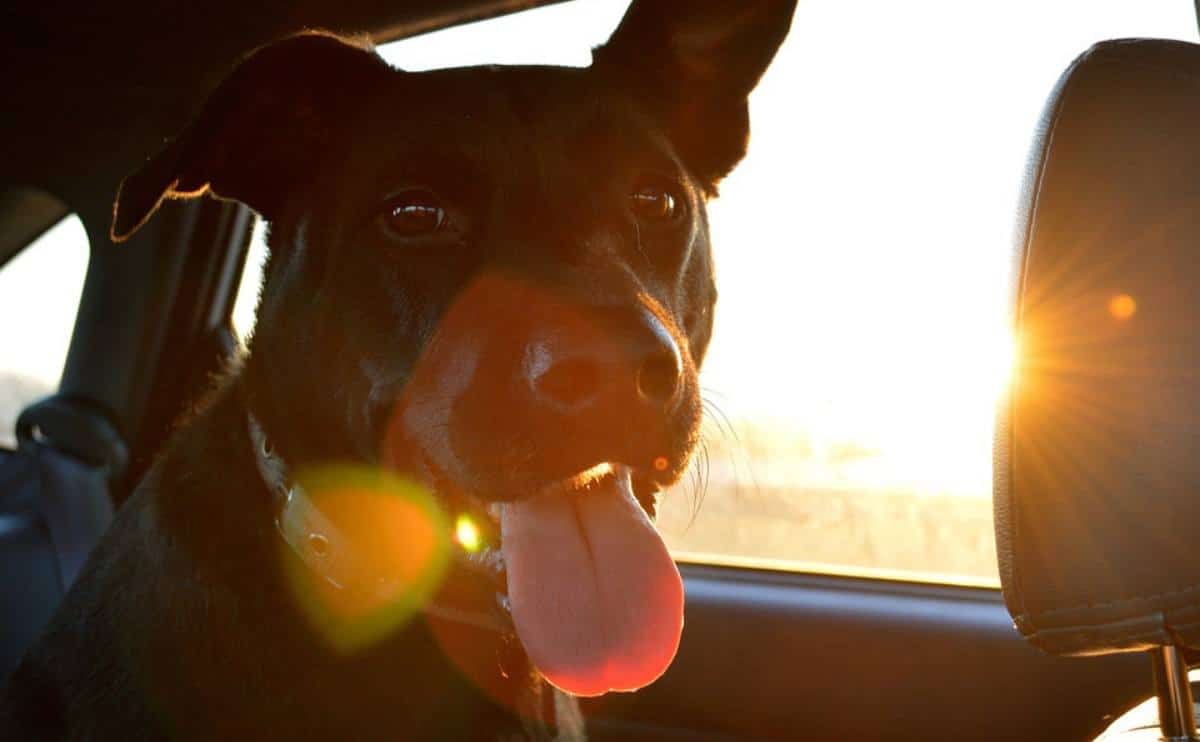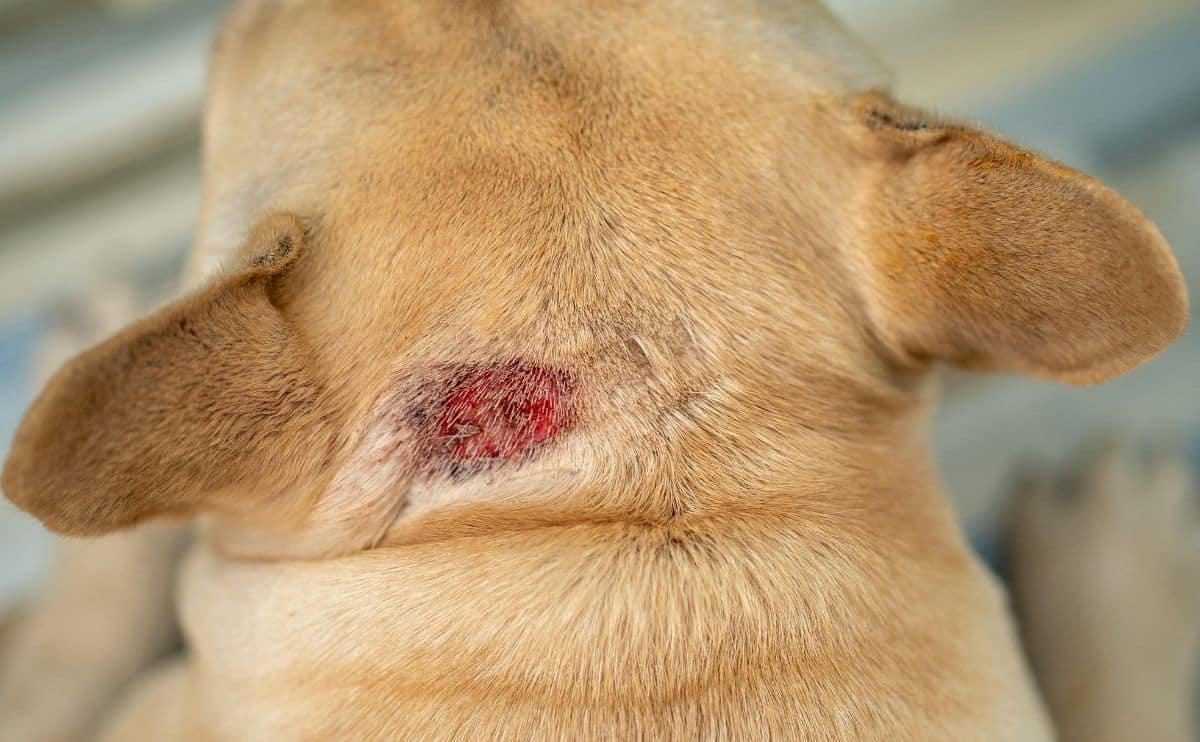Hot Spots On Dogs? This Is What You Need To Do Immediately
When you purchase through links on our site, we may earn a commission. Here’s how it works.
One second, your dog’s chilling. Next, they’re chewing their hip like it owes them money. That raw, red, gooey mess? That’s a hot spot.
Table of Contents
Hot spots on dogs are a fast-spreading skin infection that can go from mild to miserable in less than a day. If your pup’s licking, scratching, or looking like he’s trying to self-destruct, don’t panic. But you do need to act quick.
In this guide, you’ll learn exactly what hot spots are, what causes them, and how to stop the itch before it spirals out of control.
What Are Hot Spots On Dogs?
A hot spot is a red, raw, often oozing patch of skin that seems to show up out of nowhere and gets worse fast. Officially, it’s called acute moist dermatitis. But most dog owners know it as that weird wet scab their dog won’t stop licking.
At first, a hot spot appears as a small red area that might look like an insect bite. But they quickly worsen and spread, appearing as a large, moist, oozing, and red or bright pink area.
Hot spots are very painful and itchy, so dogs continually lick and chew the area, further worsening the condition. You may also notice hair loss in the area.
Hot spots are also more likely to develop in warm weather and high humidity. They can occur anywhere on a dog’s body but are most common on:
- Hips
- Neck
- Belly
- Behind the ears

What Do Hot Spots Look Like On Dogs?
Hot spots can sneak up fast, starting as a little red bump and turning into a gooey mess in a matter of hours. So, what do hot spots actually look like? Here’s what to watch for:
Early Signs
- Small red patch (moist or dry)
- The area feels warm to the touch
- Dog licking or chewing it constantly
- Fur may be matted or missing
Advanced Hot Spots
- Raw, oozing sore
- Bright red or swollen skin
- Pus or yellow crust forming
- Foul odor (smells infected)
- Your dog is visibly uncomfortable or restless
The biggest red flag? Your dog won’t leave it alone. Check out this brief video to see the sore hot spot one groomer found after she shaved a pup.
What Causes Hot Spots?
So… why do dogs get hot spots in the first place? The short answer: anything that makes your dog itch or obsessively lick.
Hot spots are the body’s messy response to irritation, whether it starts from a flea bite, allergy, or just a bored dog going to town on a scratch. The skin becomes inflamed, bacteria jumps in, and suddenly, your chill pup looks like they’re falling apart.
The long answer to “What causes hot spots on dogs?” It’s a mix of triggers you might expect and a few you probably won’t:
- Flea and mite allergies
- Insect bites or bee stings
- Allergies to food or environmental factors (grasses, trees, weeds, etc.)
- Skin wounds
- Ear infections
- Poor grooming habits
- Matted fur
- Moisture trapped in the fur from bathing or swimming
- Using plastic dog bowls (yes, really!)
- Boredom or stress (resulting in excessive licking)
- Infected or impacted anal glands
- Orthopedic problems, e.g., dogs with arthritis tend to lie down on the same area much of the time, which can create abrasions over pressure points, like hips or ankles
When dogs lick or scratch too much, they break the skin. That open wound? Bacteria see it as an invitation.
Breeds Most Likely To Get Hot Spots
Some dogs are more prone than others, especially:
- Breeds with thick coats (Golden Retrievers, Labs, German Shepherds)
- Dogs who swim a lot
- Anxious or high-energy pups left alone for long stretches

Best Treatment For Canine Hot Spots
Hot spots look scary. But with the right steps, most clear up fast. The best treatment for canine hot spots depends on how bad it is, what caused it, and how fast you catch it.
Early intervention can stop a small red patch from turning into a full-blown skin infection. Hot spots are painful, fast-spreading, and usually need both skincare and behavior changes to heal fully.
It’s a good idea to consult your vet for proper treatment and to help identify the underlying cause. Here’s what most vets recommend:
- Trim the hair gently around the spot to let air in and stop moisture buildup.
- Clean the area with a vet-approved antiseptic like chlorhexidine spray or medicated wipes.
- Administer a vet-prescribed oral or topical antibiotic to treat bacterial infections.
- Administer a vet-prescribed oral or topical steroid to control itching and inflammation.
- Keep your dog from licking or scratching the spot with an Elizabethan collar – yes, the cone of shame is back!
- Monitor the area closely for any signs of swelling, odor, or pus.
Your vet will give you instructions on how often to clean the area and give your pup the appropriate medications. As long as you follow your vet’s home treatment regimen, most hot spots quickly improve within 3-7 days.
How To Treat Dog Hot Spots At Home
Seen the vet and ready to manage the healing at home? Our step-by-step “how to treat dog hot spots at home” guide shows you how to clean, protect, and calm your dog’s hot spot. We provide more vet-approved products and clever tricks to prevent them from returning.
When To Call The Vet
Hot spots often look worse than they are. But sometimes, they are worse than they look.
If you’re not sure whether to treat it at home or head to the vet, here’s how to know it’s time to get professional help. Call the vet if:
- The hot spot is oozing yellow or green discharge
- It smells bad (like something rotting or sour)
- It’s spreading quickly, or more than one is showing up
- Your dog is in visible pain, shaking, or seems lethargic
- The area is swollen, hard, or bleeding
- You’ve tried home care for 48 hours with no improvement
- Your dog keeps reopening the spot no matter what you do
Hot spots can lead to deeper skin infections (pyoderma or cellulitis) if left untreated, especially in older dogs or those with weakened immune systems. They might need prescription meds like antibiotics or steroids, so don’t wait if it’s getting worse.

What Not To Do
- Don’t use alcohol, vinegar, or essential oils, as they can sting or worsen irritation
- Don’t bandage the area tightly, as hot spots need airflow to heal
- Don’t ignore the root cause, as treating the wound won’t help if the itching continues
How To Tell If It’s Really A Hot Spot: 5 Common Skin Issues Compared
Not every red patch is a hot spot. Dogs can develop all kinds of skin issues that look similar but sometimes need totally different treatments.
In addition to a hot spot, here are four other common conditions that often get confused with hot spots and how to tell them apart.
1. Hot Spot
A red, wet, raw patch that appears suddenly and spreads fast.
Caused by constant licking, chewing, or scratching. Usually painful, moist, and warm to the touch. They are found most often on the hips, belly, neck, or behind the ears.
2. Lick Granuloma
A dry, thickened sore from obsessive licking, often due to anxiety.
Forms slowly, usually on front legs. Feels firm, not gooey. It doesn’t ooze, but it may appear irritated or bald. The VCA states that lick granuloma is different from hot spots on dogs.
3. Ringworm
A round, scaly bald spot caused by a fungus (not a worm).
Ringworm is typically dry, crusty, and circular. It is not painful but contagious to other pets and humans. Needs antifungal treatment.
4. Mange (Mites)
A crusty, inflamed rash with intense itching and hair loss.
Mange is caused by mites burrowing into the skin. It may spread across the body and needs a vet diagnosis and prescription meds.
5. Yeast Or Bacterial Infection
Smelly, greasy patches often in ears, paws, or skin folds.
The skin may look red or thickened with brown discharge or odor. Dogs may lick the area because it’s irritated, but the infection usually starts first, not the other way around.
5 Hidden Triggers: Allergies, Stress & More
Hot spots aren’t random. Even if they seem to appear overnight, there’s usually an underlying cause, and some of the most common ones are easy to miss.
1. Allergies
Dogs can react to food, grass, pollen, dust mites, or even flea saliva. Allergic skin can become itchy and inflamed, kicking off a scratch-lick-hot spot spiral.
- If hot spots keep coming back, ask your vet about allergy testing or try a limited-ingredient diet.
2. Stress & Boredom
Some dogs lick obsessively when they’re anxious or under-stimulated. Left alone too long? No walk in two days? That nervous energy can show up as self-trauma.
- Look for hot spots on the front legs or paws, a classic sign of compulsive licking.
3. Moisture Trapped Under The Fur
Dogs who swim, roll in wet grass, or aren’t fully dried after baths are more likely to develop hot spots, especially breeds with thick coats.
- Use a towel and a blow dryer on a low, cool setting, especially around the neck, tail base, and armpits. Even small damp spots can trigger a hot spot by morning.
4. Poor Grooming Or Matted Fur
Mats can trap dirt, moisture, and bacteria against the skin. A hot spot can easily form underneath without being noticed until your dog starts chewing.
- Brush your dog regularly, especially behind the ears, under the collar, and around the legs. Mats can hide hot spots until they’re already infected.
5. Plastic Food Bowls (Yes, Really)
Plastic bowls can develop tiny cracks over time, which trap bacteria and grime, even if they look clean. That bacteria can irritate the skin around your dog’s mouth and chin, leading to scratching or rubbing that may trigger a hot spot.
- Switch to stainless steel or ceramic bowls. They’re easier to clean, less likely to harbor bacteria, and don’t wear down as quickly.
Hot spots are usually a symptom, not the root problem. If your dog keeps getting them, it’s time to investigate what’s triggering the itch in the first place.
How To Prevent Hot Spots: 9 Ways
Hot spots often come back unless you fix the cause, not just the sore. The good news? Most hot spots can be prevented with a few simple habits.
Flea control and proper bathing and grooming may be your best bet against future hot spots. However, many of the conditions that trigger hot spots are chronic problems, like skin allergies and ear infections.
So, it’s important to identify and manage the underlying cause to prevent recurring hot spots and skin problems.
1. Brush Your Dog Regularly
Brushing removes dirt, dander, and loose fur while preventing mats that trap moisture and bacteria, which are prime conditions for hot spots.
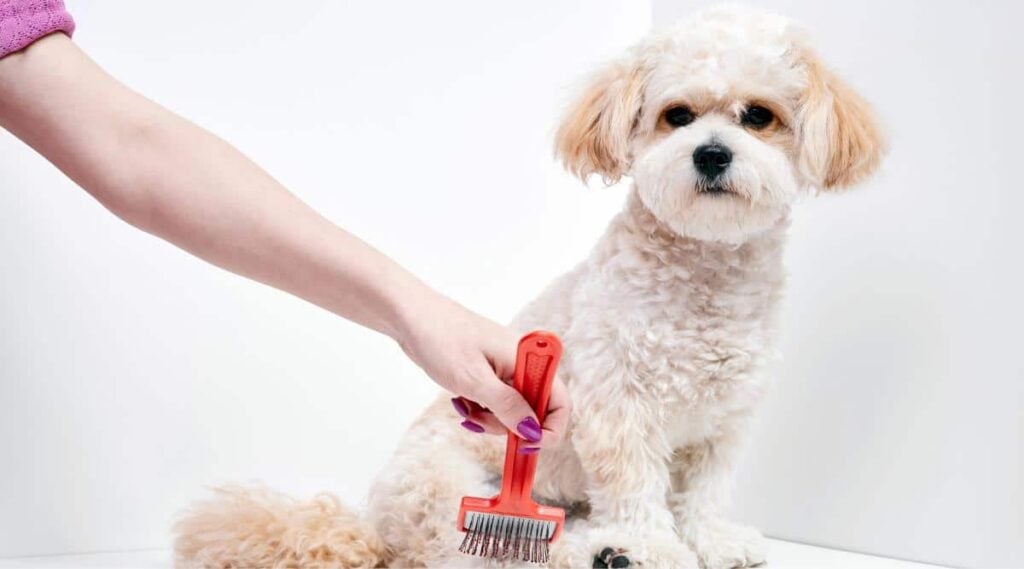
2. Dry Thoroughly After Baths Or Swimming
Damp fur, especially in thick-coated breeds, can breed bacteria fast. Towel-dry thoroughly, then use a blow dryer on a cool setting to finish the job.
3. Check For Fleas & Ticks Weekly
Flea bites are one of the top causes of hot spots. Even a single bite can trigger obsessive scratching in sensitive dogs.
4. Use Flea Prevention Year-Round
Even indoor dogs can pick up fleas. Consistent, vet-approved flea control helps prevent the itch-scratch cycle that leads to hot spots.
5. Identify Allergies
If you suspect your dog’s recurring hot spots could be due to allergies, contact your vet to discuss your dog’s symptoms. You can also help identify your dog’s specific sensitivities to food and environmental factors through an at-home dog allergy test, like the EasyDNA Dog Allergy Test.
Learn more about identifying allergies in our dog allergy test kit reviews.
6. Relieve Boredom & Stress
If you think your dog is licking or chewing due to boredom, try increasing their daily exercise, playtime, and overall mental stimulation with the help of these top dog toys.
If your dog suffers from frequent stress, consider giving them CBD oil for dogs to help relieve their anxiety.
7. Clean Bowls, Bedding & Toys
Dirty surfaces can harbor bacteria that irritate your dog’s skin, especially around the face, ears, and neck. Wash these items weekly.
8. Watch For Early Signs
Catching it early is everything. If you notice your dog licking one area repeatedly, immediately check the skin. It could be the start of a hot spot.
9. Use A Cone Or Recovery Sleeve When Needed
If your dog keeps licking one area, even before a hot spot forms, it’s time to block access. Using a cone or a recovery dog sleeve can prevent constant irritation and give the skin time to heal before it breaks open.
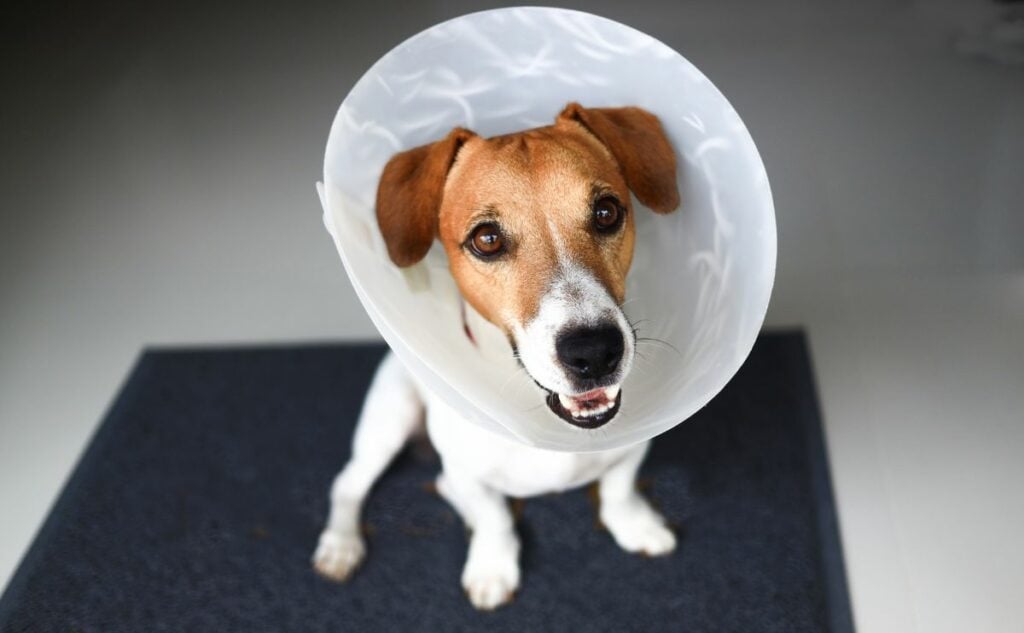
For a more comfortable alternative to the cone, the FUAMEY Dog Recovery Sleeve is a smart option. It’s designed to protect wounds or irritated skin from licking and scratching on the front legs while allowing full movement and breathability. The fabric is soft, stretchy, and adjustable, making it ideal for longer wear during healing or as a preventive tool for dogs prone to hot spots.
Our Personal Experience With Dog Hot Spots
My sweet dog Daisy has been battling a relentless hot spot on her leg, and it’s heartbreaking to watch her suffer. I’ve tried everything: anti-chew sprays, bandages, and an array of topical treatments to heal the raw, painful sore.
For a brief time, CBD cream offered a bit of relief, giving her some solace from the irritation. But nothing has provided a lasting solution.
After a visit to the vet, I followed their advice and started giving her Benadryl. The thought was that the spot is allergy-related. It helps, but only a little.
What has truly worked is keeping her from accessing the spot altogether. Daisy’s tendency to lick obsessively, day and night, turns the hot spot into a bloody, inflamed wound.
To protect her, I’ve resorted to dressing her in arm sleeves or recovery shirts, creating a barrier between her and the sore. These measures feel like a last resort, but they’re the only way to give the wound a chance to heal.
The last time, she had to wear the recovery shirt for six long weeks, six weeks of patience and care just to see her leg finally mend. And, of course, as soon as the sleeve comes off, she’s back at it.
– Danielle DeGroot, Rescue Dog Mom & Canine Journal Writer
4 Supplements That Actually Help
If your dog keeps getting hot spots, daily supplements can help strengthen their skin, reduce inflammation, and address underlying issues like allergies or stress. Here are a few that vets often recommend.
1. Omega-3 Fatty Acids (Fish Oil)
Omega-3s support skin hydration and reduce inflammation. Dogs with dry, itchy skin or seasonal allergies often see a major improvement with daily fish oil.
Tip: Look for high-quality, purified fish oil with DHA and EPA. Liquid formulas are easy to mix into food, whereas some dogs prefer chews.
Zesty Paws Omega 3 Alaskan Fish Oil Chew Treats are an excellent option. They help promote healthy skin and also have anti-inflammatory properties, so they can help ward off hot spots by making your dog less susceptible to allergens and infections.
We have a guide on the best fish oil for dogs to help you find the best option for your pup’s preferences.
2. Probiotics
A healthy gut supports a healthy immune system, and that includes skin health. Probiotics can help dogs with food sensitivities or chronic skin issues by improving digestion and reducing inflammation.
Tip: Choose a canine-specific probiotic, not a human one.
Nusentia Probiotic Miracle is a top choice for many dog owners. This blend contains six different strains and a prebiotic to combat itching & scratching, allergies, digestive and other issues.
Head over to our comprehensive guide on dog probiotics to learn more about their benefits and the best options out there.
3. Allergy Support Chews
Some supplements combine quercetin, bromelain, and vitamin C to support immune function and reduce histamine responses. These can be helpful for dogs with seasonal or environmental allergies.
Tip: Check the label for artificial fillers as some “natural” chews sneak in low-quality ingredients.
If you’re looking for an all-in-one supplement to support skin health and reduce itching, Pet Honesty’s Allergy SkinHealth Chews are a great choice.
They combine omega-3s, probiotics, and natural anti-inflammatories like turmeric and colostrum to target hot spot triggers from multiple angles, especially allergies and immune sensitivity.
We have a guide on the best allergy supplements and allergy shots for dogs to help your pup feel better.
4. Calming Supplements
If your dog’s hot spots are linked to anxiety or obsessive licking, calming aids with ingredients like L-theanine, chamomile, or melatonin can reduce stress behaviors.
Tip: Use calming treats daily during high-stress periods (storms, fireworks, travel, schedule changes) or as part of a training and enrichment plan.
Pet Honesty Hemp Calming Treats can be a helpful part of your prevention plan for dogs whose hot spots are linked to anxiety or compulsive licking. They’re made with proven calming ingredients like L-theanine, chamomile, valerian root, and hemp, all known to reduce nervous behaviors without sedation.
These chews can ease stress during alone time, loud events, or daily transitions, helping break the itch-lick cycle before it starts. Bonus: most dogs love the taste.
Read our guide on the best calming supplements and treats for dogs to help you help Fido feel more like themself again.
FAQs: Your Top Hot Spot Questions
Still have questions? Here are the answers to dog owners’ most common questions about hot spots. If you have a question you don’t see, ask us in the comments, and we’ll find the answer for you.
How Fast Can A Hot Spot Spread?
Very fast. Some hot spots can double in size within 12–24 hours if your dog keeps licking or scratching it.
Can Hot Spots Go Away On Their Own?
Rarely. Most need to be cleaned, treated, and protected from further licking. Left alone, they often get worse or infected.
Are Hot Spots Painful For Dogs?
Yes. They’re inflamed, raw, and often very itchy. Many dogs act restless, irritated, or protective of the area.
Should I Cover A Hot Spot?
Usually, no. Covering it tightly can trap moisture and slow healing. Focus on keeping it clean, dry, and exposed to air while preventing licking.
But in some cases you might have to use a recovery sleeve to prevent your pup making it worse. In this case, you must choose a loose(ish)-fitting and breathable option.
When Should I Take My Dog To The Vet?
If the hot spot smells bad, spreads quickly, has pus, or isn’t improving within 48 hours, even with home care, call your vet.
Will My Dog Get Hot Spots Again?
Possibly. Recurring hot spots usually mean an underlying issue such as allergies, anxiety, or poor grooming, all of which need to be addressed.
Keep Your Dog Healthy From Head To Tail
Preventing hot spots is just one part of keeping your pup happy and itch-free. A diet of high-quality dog food can support skin health from the inside out.
Don’t skip those annual vet visits, as they’re your first line of defense against hidden issues like allergies or infections. If unexpected health problems arise, having the best pet insurance can often help you manage costly surprises.
Lastly, every pet owner should keep a well-stocked dog first aid kit at home because you’ll want to be ready when something flares up fast.
If you’ve dealt with hot spots on your dog, we’d love to hear about your experience. Share your tips, questions, or what finally worked for your pup in the comments. Your story might help another dog parent who is going through the same thing.
